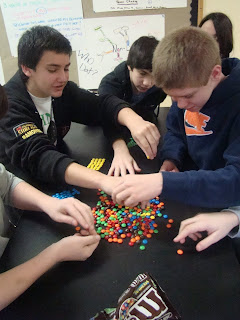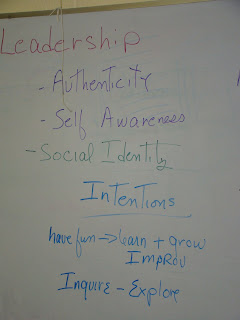
Joyce Richman joined SOAR as guest speaker on Febuary 23. A former 8th grade Jewish day school teacher in Beverly Hills, she was delighted to visit B'nai Shalom. She remembered doing some substitute teaching at B'nai Shalom in the early days of the school's history. Joyce now does career counseling for adults and leadership training.
Joyce referred back to the Myers Brigg personal style inventory completed by the class several weeks ago when describing extroverts and introverts. "Introverts," she said, "think before they speak. Extroverts do not." Students were asked to define themselves as introverts or extroverts. As they raised their hands, Nicole checked their self-assessments with their actual Myers Briggs results.
Extroverts in the class suggested that introverts were "shy." Joyce differentiated between introverted and shy, and reminded students to be mindful of the source of the introverted behavior - thinking before speaking. Extroverts might want to say, "I haven't thought this through yet but..." letting the listeners know that they have not yet finished their thought. "Effective communication," she said, "will have enormous influence on those around you. Who is a good communicator and what does that person do that is so effective?" Samuel suggested that President Barak Obama is a good communicator, using clear language to discuss complex issues. Matt suggested that our constant exposure and familiarity with his style made us find him a good speaker. In other words, the relationship between the president and the public - visibility - made him a good communicator to his audience.
Students learned that leading and communicating require visibility. Jessie added that the president's body language made him a good communicator. Kendell mentioned eye contact as a key way to develop a relationship with the person who is talking, adding that "Eye contact makes you listen more beause of the physical connection." Dima noted that eye contact was tuned in to the rest of the body language.
Joyce cautioned the students to be mindful of their own body language: crossing arms indicating closed emotions; open arms indicating openness to conversation. "Communicating is about negotiation," she said. After Matt said that body language can indicate being genuine, Joyce asked the students to think about the individuals they know who connect with them in a genuine way and use them as models. Dima suggested that Matt is a good communicator because he uses language that all are able to understand. Smiling, nodding, encouraged the relationship building that Matt does. Joyce mentioned that body language may also work against the intended message, such as someone who nods when he/she really means, "no."
Students discussed that some individuals take in information through their tactile senses. People who are intuitive pick up information through sensing. This may conflict with people who trust facts. These two groups may conflict in discussing information. Students were asked whether or they defined themselves as intuitive or fact-driven.
Joyce asked students to define good communication techniques. Listening to others, commenting on the opinions of others (building on others' comments without negativity), good eye contact, not forcing someone to say something until he/she is ready were all added to the list. Joyce connected leadership to mindfiulness - because others observe what we do.
Judy challenged the class to observe their teachers for the rest of the day and note any non-verbal comminication messages they received.



















